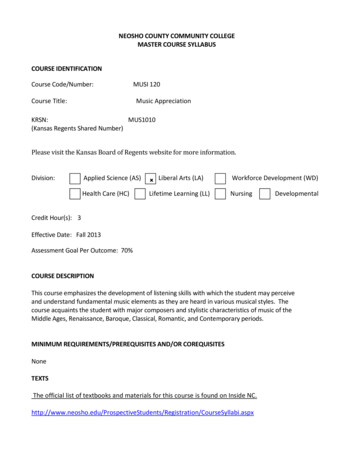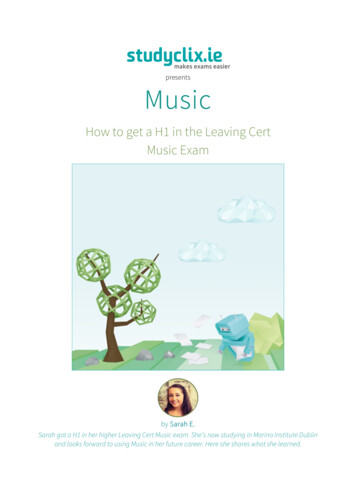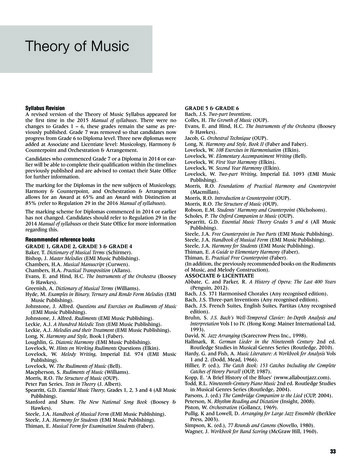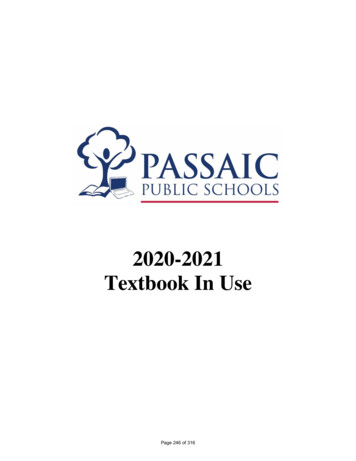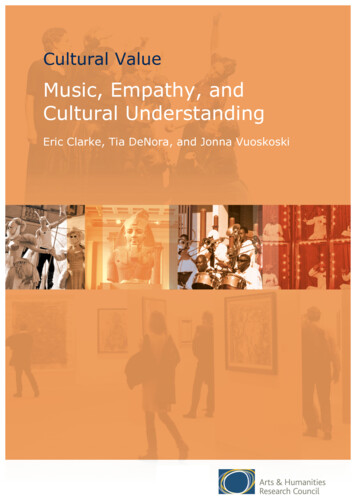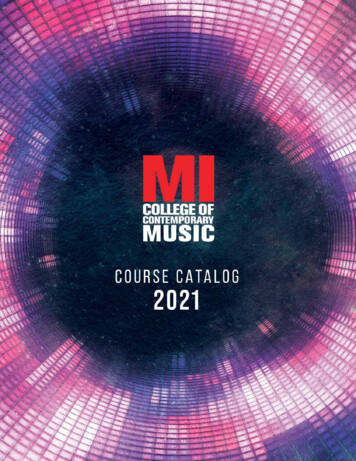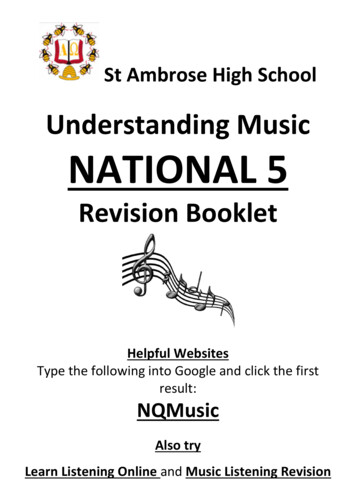
Transcription
St Ambrose High SchoolUnderstanding MusicNATIONAL 5Revision BookletHelpful WebsitesType the following into Google and click the firstresult:NQMusicAlso tryLearn Listening Online and Music Listening Revision
Important concepts you need to knowHomophonic – Texture - all parts move at same time ormelody with accompaniment – same rhythms at thesame time.Polyphonic – Texture 2 or more parts with differentrhythms - weave independently of each other. LikeContrapuntalLegato – Notes played smoothlyStaccato – Notes played short and detachedOstinato/Riff - Repeated pattern of notes over and overSequence – Pattern of notes repeated higher or lowerRepetition – Musical idea heard more than once.Imitation –The melody is immediately copied inanother part.Unison – Same notes at the same time.Harmony – Different notes at the same time.Anacrusis – Tune starts before the first beat of the bar.Think “happy” in happy birthday.Syncopation – Strongly accented notes playing off oragainst the beat. Will sound more jumpy.Symphony – Piece for whole orchestra, no main soloinstrument.Concerto – Piece for soloist and orchestraCadenza – passage for soloist to show off, soundsmade up – improvised.
A capella – Unaccompanied – no accompanyinginstruments.Melismatic – More than one note per syllable.Syllabic – One note per syllable.Major – Happy, positive sounding.Minor – Sad, scary, tense sounding.Atonal – Not major or minor – uses dissonance –doesn’t sound nice.Forms - Binary – 2 sections – A & B Ternary – 3 sectionsA BARondo – Lots of sections with A repeated eg. A – B – A –C–A – DTheme & Variations – Main theme is played and thenchanged in a different way each variation eg. put intominor key, notes added to tune, different beats in a bar.Minuet & Trio - dance with 3 beats in a bar.Alberti bass - Broken chords played by the left hand onthe piano. Low - high – middle – high.Walking Bass – Notes move on every beat.Ground Bass - A theme in the bass which is repeatedmany times while the higher parts change.Broken chord – Notes of the chord played separately.Vamp – Boom cha accompaniment. Bass note then chord.
Simple time – Each beat splits into 2 equal parts –TAN-GOCompound time – Each beat splits into 3 equal parts –JIGG-I-TY.Aria – Main song in an opera. Shows off the singersability-tuneful.Cadence – Last 2 chords in a phrase.Perfect Cadence sounds finishedImperfect Cadence sounds unfinished.Tierce De Picardi – Minor piece last chord major.Pedal – Low note held on or repeated while other partschange.Inverted Pedal - High note held on/repeated whileother parts changeModulation – Change of key.Voices – Highest to lowestSopranoMezzo Soprano FEMALEAltoTenorBaritoneBassMALE
TEMPOS – lerandoRallentandoFastModerate tempoWalking PaceSlowgetting fastergetting slowerRubatorobbed time – speeding up or slowing down to suitthe mood of the piece.DYNAMICS – LOUDS & QUIETSDynamicppItalianPianissimopPianovery quietquietmpMezzo-pianomoderately quietmfMezzo-fortemoderately oloudlyvery loudlyGradually gettinglouderGradually gettingsofterEnglish meaning
Instruments & Related ConceptsStringsConcepts/Playing TechniqueViolinViolaCelloDouble BassHarp / ClarsachArco BowedPizzicato n - Air is blown throughinstrument to produce soundFlutter Tonguing - Rolling your Rs whileblowing a note.Saxophone(not in orchestra)BrassTrumpetFrench HornTromboneCon Sordino - Muted - creating a differentsound than normally.expected.TubaPercussionUntuned PercussionTuned PercussionSnare DrumDrum-kitCow BellBass etal)VibraphoneTimpani (kettle drum)Tubular BellsBodhranBongo DrumsGuiroCastanetsTambourine
Musical Groups / STYLESOrchestraBrass BandWind BandFolk Group-Scottish dance bandCeltic g-Strings, Brass, Woodwind, PercussionBrass & PercussionBrass, Woodwind, PercussionFiddle, Guitar, Vocals, Accordion,Whistle, Bass, Flute, Drum kit, Bodhranfiddle, accordion, piano, drums.Mixes folk music with rock music.Off beat guitar, vocals, drums, organ, bass.Sounds dreamy or blurry. Whole tone scale.Simple and repetitive ostinatos.Piano. Syncopated melody & vamp accomp.Jazz style, developed from black Americanfolk songs. Tells a story. Flattened notes.A jazz style performed by a big band.Scottish MusicDanceSpeedBeatsOther featuresWaltzMedium3Only dance with 3 beatsJigFast2 – 6/8 time STRAWBERRY, compound time,ReelStrathspeyMarchFastMediumMarching speed442 or 4TANGO, simple time, flowingJumpy, Scotch SnapSteady, strong pulse.Accomp?Other?Waulking Song Women At workNoBeating soundBothy BalladMenFarm workUsually noTells storyGaelic PsalmBothChurch NorthScotlandNoIn Gaelic, Call &Response, not nice.Mouth MusicBothNonsense made Maybeup Gaelic wordsImitating melody ofbagpipesScots BalladBothTelling storyLots of verses andchorus,SongWho?Where/About?Maybe
Literacy TipsNameLength (beats)Semibreve4Dotted Minim3Minim2Dotted Crotchet1 1/2Crotchet1Dotted Quaver3/4Quaver1/2Semiquaver1/4Key SignaturesC Major 0 sharps or flatsA Minor 0 sharps or flatsBut G#s in music.F Major 1 flat BbG Major 1 Sharp F#
LinesEvery Good BoyDeserves FootballNotes below the staveSpacesFACENotes above the staveRepeat SignsStartEnd1st & 2nd time barsTime Signatures – go right at the beginning of the first line –beside the treble clef. 2 crotchet beats per barSimple time 3 crotchet beats per barSimple time 4 crotchet beats per barSimple time 2 dotted crotchet beatsper bar- Compound Time
MelodyHarmonyRhythmTempoInstruments andhow they are usedRepetitionSequenceImitationModulationChords/ DiscordsBroken atonicQuestion &AnswerGlissandoHomophonic/PolyphonicOrnaments: trill,grace notesLegato copationRepetitionOstinatoAnacrusisBeats in a bar /Time Signature:2/4, 3/4, 4/4, SimpleTime6/8 – Compound TimeSpeed: Allegro – FastAdagio – SlowAndante – walking paceModerato – moderateSpeed Changes:Accelerando – fasterRallentando – slowerRubato – with freedomDotted RhythmsScotch SnapBrass – Trumpet, French Horn, Trombone,TubaWoodwind – Piccolo, Flute, Oboe, Clarinet,Bassoon, Saxophone, RecorderStrings – Violin, Viola, Cello, Double Bass,HarpPercussion – Xylophone, Glockenspiel,Timpani, Triangle, Snare Drum, Drumkit,Bass Drum, Tambourine, CastanetsKeyboard – Piano, Synthesizer,Harpsichord, Organ, CelesteVoices – Soprano, Mezzo Soprano, Alto,Counter Tenor, Tenor, Baritone, BassGuitars – Electric, Acoustic, Bass, BanjoSolo, Melody, CountermelodyAccompaniment, Chords, Broken ChordsGlissando, ArpeggiosArco – bowed, Grace notes, ornamentsMuted, Pizzicato - pluckedCol Legno – wood of bow, Double StoppingFemale: Soprano, Mezzo Soprano, AltoMale: Tenor, Baritone, BassCountertenor – high like a woman.Solo; Accompaniment; Melody;CountermelodyDynamicspp – pianissimo – very quietp – piano – quiet.mp – mezzo piano –moderately quiet.mf – mezzo forte –moderately loud.f – forte – loud.ff – fortissimo – very loudChanges of dynamiccrescendo – getting louderdiminuendo – gettingquieter.
CategoriesTONALITYMAJORMINORATONALSTRUCTUREBINARY FORMTERNARY FORMTHEME & VARIATIONSTROPHICRONDO FORMTEXTUREHOMOPHONICPOLYPHONIC/CONRAPUNTALPERIODS OF MUSICBAROQUECLASSICALROMANTICMODERN
National 5 – Understanding Music Paper LAYOUTQuestion 1a-f - 6 Marks: Multiple Choice with a few “writethe word” questions.Question 2: Box question (musical map) - 4 Marks4 numbered boxes. Voice says the number over the music & you mustanswer the question in the related box when the number is said.Question 3: Literacy Question – 6 MarksEg. Name the key of this piece, insert the time signature, insert missingnotes, insert repeat sign, identify octave leaps, write dynamics, writetempo marks.
Question 4: Multiple Choice – 8 MarksQuestion 5: - 4 MarksTick one box fromeach section.Question 6: Fill in the missing words – 3 MarksQuestion 7: - 4 Marks - Reason Question: Multiple choice pluswrite reason for answer.Question 8: - 5 Marks Write about the prominent features you hear inthe music.Fill out this box then transfer it to the lines on the next page.rhythm/tempomelody/harmonyInstruments/voices andhow they are useddynamics
A capella - Unaccompanied - no accompanying instruments. Melismatic - More than one note per syllable. Syllabic - One note per syllable. Major - Happy, positive sounding. Minor - Sad, scary, tense sounding. Atonal - Not major or minor - uses dissonance - doesn't sound nice. Forms - Binary - 2 sections - A & B Ternary - 3 sections A B A
